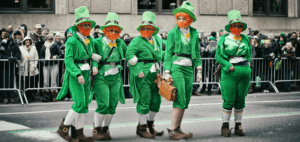Experience the History Behind these Abandoned Castles in Scotland
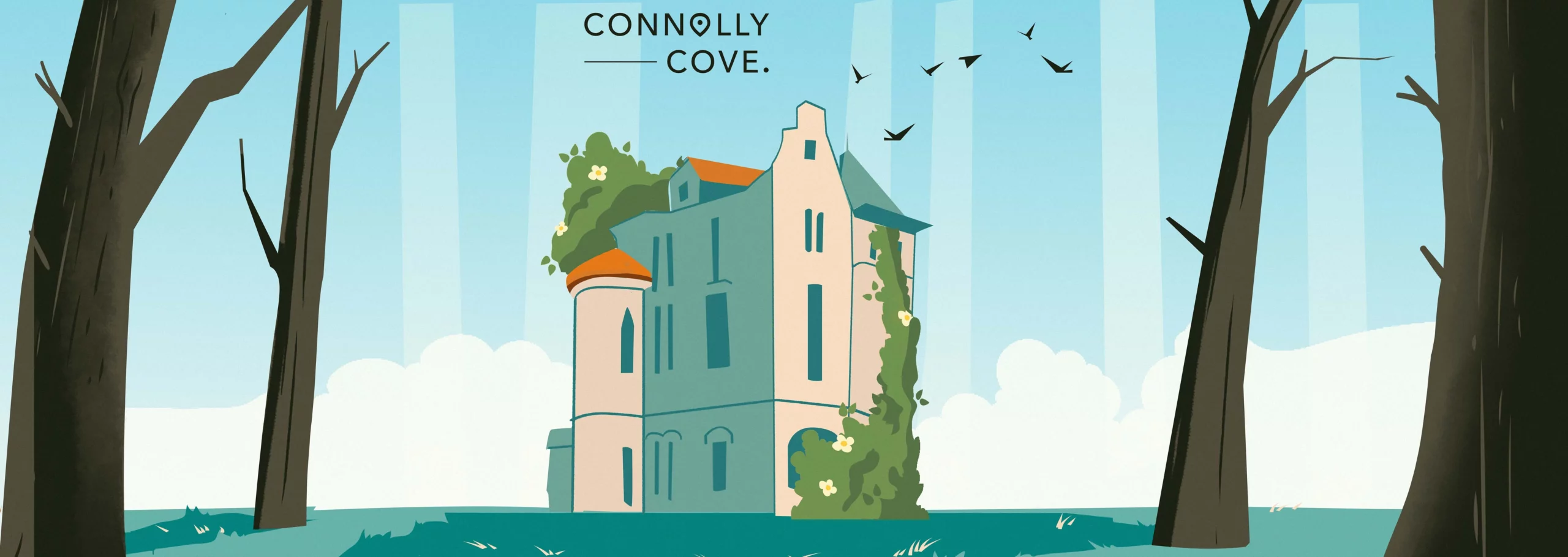
Updated On: November 09, 2023 by Aya Radwan
Abandoned castles are not just beautiful works of architecture that are worth admiring. They tell history, the stories of the people who once walked through their hallways, the emotions they once held, the formed alliances and scheming political agendas born within their walls. Scottish history tells us of the many beautiful castles dotted around the country, but abandoned castles in Scotland are rather scarce.
In this article, we’ve searched the country for these abandoned castles to bring them to you. We promise their history is full of all the dramatic events you’ll love; some even have teeth-gritting history to show.
Abandoned Castles in Scotland
Dunalastair House, Perthshire
Dunalastair House, or the Fort of Alexander, is an abandoned castle that stands on the ruins of two previous dwellings. The first dwelling was The Hermitage, where Alexander Robertson of Struan, of Clan Donnachaidh, lived, and the second was Mount Alexander, a double tower house. When the 18th chief of the clan sold the estate to Sir John Macdonald of Dalchosnie, the old buildings were demolished to make way for the new one, the current ruinous house.
The current Dunalastair House was completed in 1859, and it remained in the Macdonald’s ownership until Sir John’s son, Alastair, sold it in 1881. The estate was sold several times before it landed in the ownership of the current owner’s family, James Clark Bunten. James is the great-grandfather of the current owner of Dunalastair House.
After WWI, keeping the staff that could run the entire house was difficult, so it was abandoned as a residence. However, after WWII, the house was used as the location of a boys’ and, later, a girls’ school. During this time, the house was severely damaged, and a fire broke out in the drawing room, causing much damage, including a valuable painting by John Everett Millais.
Further damage only followed after that; in the 1950s, the house’s contents were sold, and in the 1960s, the house was vandalised and lead was stolen from the roof. The damages were too expensive to repair, and almost any removable part of the house was stolen.
Perhaps the only untouched part of the estate is the beautifully-decorated graveyard, which holds the tombs of five of the Robertson Clan, or Clan Donnachaidh.
Old Castle Lachlan, Argyll and Bute
Clan MacLachlan built this currently ruined and abandoned castle in the 14th century, which is one of the legends surrounding its construction. Written accounts of the fort date it to different centuries, sometimes the 13th century and other times the 14th century. Architects used the fort’s design to date its time of construction back to either the 15th or 16th century.
MacLachlan’s 17th chief was a fierce Jacobite and supported the cause in all their battles. Most notably when Lachlan MacLachlan led a faction of his clan into the Battle of Culloden, the last battle of the Jacobite Uprising in 1745. The fierce battle resulted in many casualties, including Lachlan himself, who lost his life to a cannonball. Upon defeat, the remaining MacLachlans fled the Old Castle Lachlan before it was bombarded and reduced to ruins in 1746.
For several years, Old Castle Lachlan remained in a ruinous state and uninhabited. However, three years later, the Duke of Argyll intervened to mediate the return of the estate and the clan lands to the 18th clan chief, Robert MacLachlan, who was only 14 at the time. A year later, the clan built the New Castle Lachlan, and it became their main residence, and they abandoned the old estate ever since.
The New Castle Lachlan remains the residence of the Clan Maclachlan today.
Edzell Castle and Garden, Angus
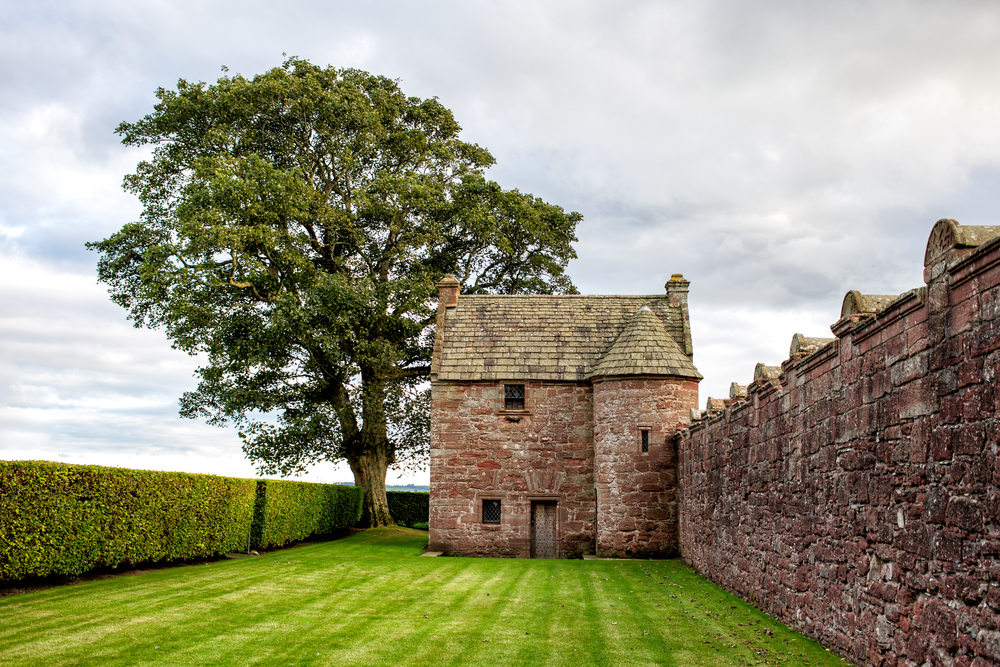
Edzell Castle is an abandoned 16th-century fort that stands on the remains of a timber castle from the 12th century. Part of the original mound can still be seen a few metres away from the current ruin. The old building was the base of the Abbott Family and the old Edzell village.
Through succession, Edzell became the property of The Lindsays in the first quarter of the 16th century. By then, David Lindsay, the owner, decided to abandon the old dwellings and build a new estate. He chose a sheltered location to build the new tower house and courtyard in 1520. He carried further expansions in 1550 by adding a new gate and hall to the west.
Sir David had great plans for the estate afterwards; he drew plans for a new north range and the gardens surrounding the estate, which he designed to incorporate unification symbols of Britain, Ireland and Scotland. Sadly, Sir David died with great debts, which put the plans on hold, and none of his successors finished his plans.
Cromwell’s forces took over Edzell and stayed there for a month during the Third Civil War in 1651. Accumulating debts led the last Lindsay Lord to sell the estate to the 4th Earl of Panmure, who in turn forfeited his possessions after taking part in the failed Jacobite Rebellion. The estate eventually landed in possession of the York Buildings Company, which began to assess the standing buildings for sale. When a government troop took residence in the estate in 1746, they caused further damage to the falling buildings.
Edzell Castle returned to the ownership of the Earls of Panmure when the York Buildings Company sold it to the family because the company was bankrupt. Through succession, Edzell passed down to The Earls of Dalhousie, the 8th Earl, in particular, George Ramsay. He entrusted the estate to a caretaker and had a cottage built for his residence in 1901, and the cottage now serves as the visitor centre. The state took care of the walled gardens and the estate in 1932 and 1935, respectively.
Old Slains Castle, Aberdeenshire
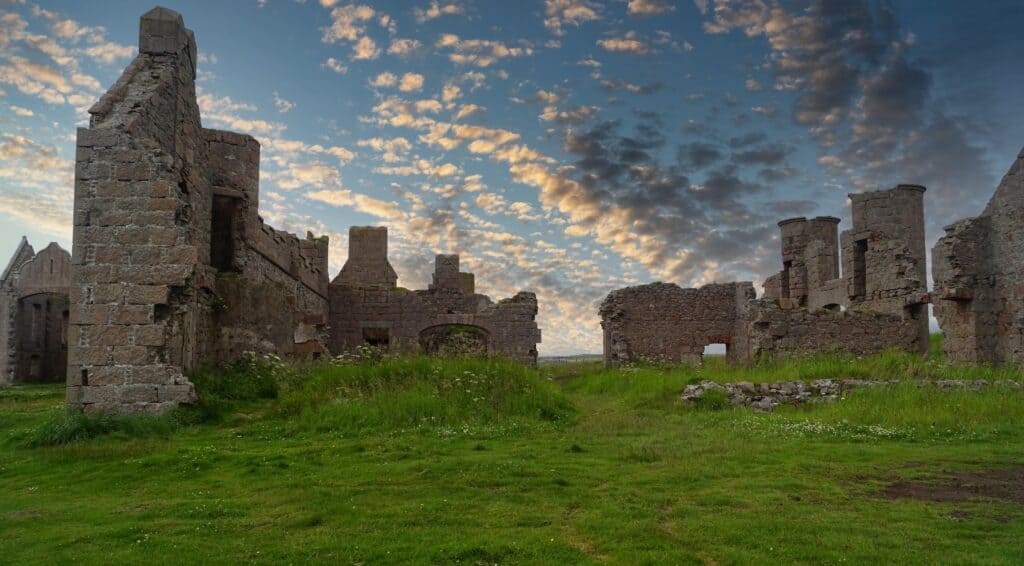
The Old Slains Castle is a ruinous 13th-century castle as property of the Earl of Buchan, The Comyns. Following the confiscation of The Comyns’ possessions, Robert the Bruce granted the estate to Sir Gilbert Hay, the 5th Earl of Erroll. However, it was the 9th Earl of Erroll – Francis Hay’s actions that prompted King James VI to order the destruction of the estate with gunpowder. The entire fort was blown up in November 1594, and only two walls still stand today.
Despite the Countess of Erroll, Elizabeth Douglas’s efforts to rebuild the estate the following year, destruction had reached a no-return point. Instead, Francis Hay later built the Bowness, a tower house, which later served as the site for the New Slains Castle. The last additions to the site of the Old Slains Castle include an 18th-century fishing cottage and an adjacent house built in the 1950s.
New Slains Castle, Aberdeenshire
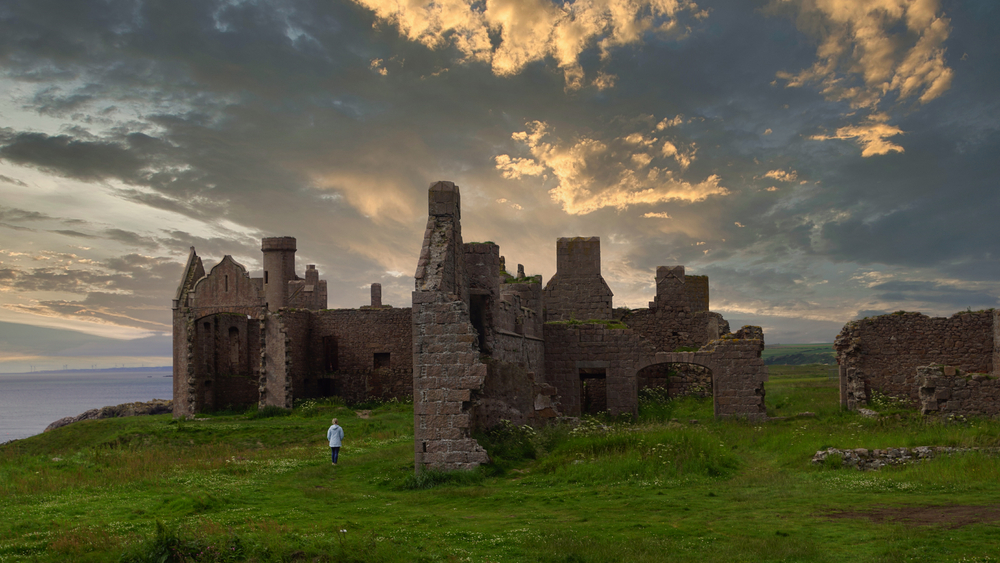
After The Hays relocated to the Bowness, the site served as their habitat for years. The original tower house was used as the centrepiece of the new estate near Cruden Bay. The first additions to the now abandoned castle date back to 1664 when a gallery was added, and the place acquired its new name, the New Slains Castle.
New Slains Castle was linked several times with the Jacobite Cause. The first time was when French King Louis XIV sent Nathaniel Hooke, a secret agent, to try and ignite a Jacobite rebellion in Scotland and failed. This resulted in the attempted French invasion of England in 1708, using French and Jacobite forces to subdue Scotland, but the invasion was brought to an end by the British navy.
The fort hadn’t seen many alterations from its original design until the 18th Earl of Erroll commissioned a remodelling in the 1830s and added construction plans for gardens. Before the 20th Earl of Erroll sold New Slains Castle in 1916, it had several high-profile tenants such as Robert Baden-Powell and Herbert Henry Asquith as Prime Minister, who also entertained Winston Churchill as his guest at the estate.
After moving from the possession of several families during the 1900s, New Slains Castle stands now as a roofless estate. The different architectural styles visible on the ruins show different eras, from the end of the 16th century to that of the 17th century. Some defensive works are still seen today, although they’re mostly ruins, such as the ruined rampart. Different storage spaces and kitchenware are still well-preserved, and some archways reflect the medieval architectural style.
Dunnottar Castle, South Stonehaven
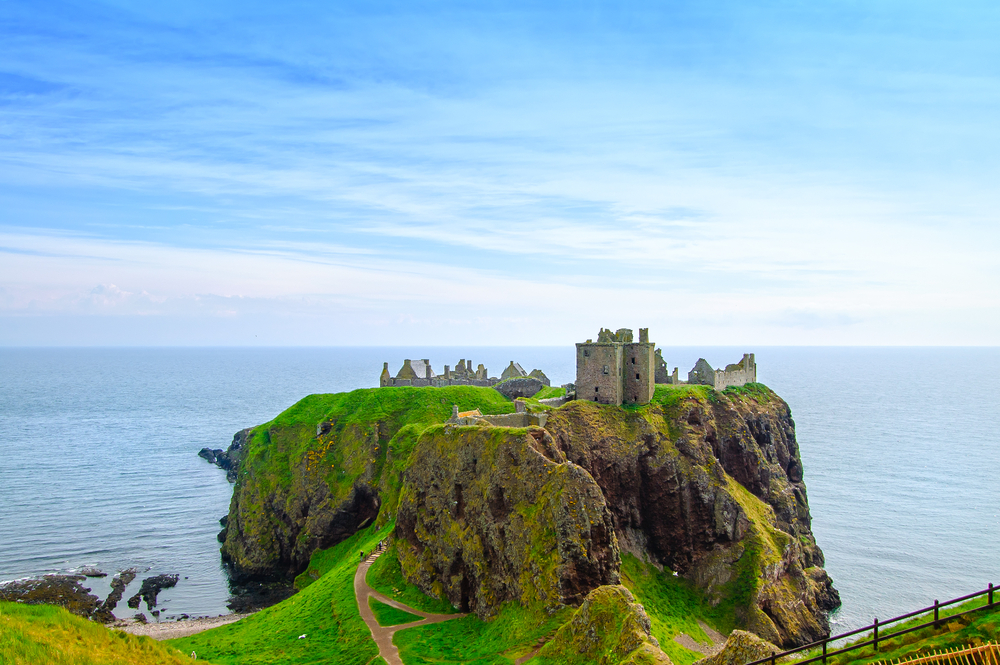
Dunnottar Castle, or “fort on the shelving slope”, is a strategic abandoned castle located on the northeastern Scottish coast. Legend says that St Ninian founded a chapel at the site of Dunnottar Castle in the 5th century; however, neither this nor the exact date the site was fortified is known. The Annals of Ulster mentions Dunnottar Castle by its Scottish Gaelic name, Dùn Fhoithear, in two accounts of political sieges as early as 681, which act as the earliest historical mention of the fort.
This ruined fort witnessed many significant events in Scottish history. Vikings raided the estate in 900 and killed King Donald II of Scotland. William Wishart consecrated the church on the site in 1276. William Wallace seized the estate in 1297, imprisoned 4,000 soldiers inside the church, and burned them. King Edward III of England put plans to restore, fortify and use Dunnottar as a supply base. Still, all exerted efforts were smashed when Sir Andrew Murray, the Scottish Regent, captured and destroyed the defences.
From the mid-14th to the 18th century, William Keith, the Marischal of Scotland, and his descendants were the owners of Dunnottar. They worked to ensure the fort’s political status, which was asserted by several visits from British and Scottish royals, such as King James IV, King James V, Mary Queen of Scots and King VI of Scotland and England. Although George Keith, the 5th Earl Marischal, undertook the most significant of restorations of Dunnottar Castle, his restorations were preserved as decorations rather than actual defences.
Dunnottar Castle is most famous for holding the Honours of Scotland or the Scottish Crown Jewels from Cromwell’s forces after they were used in the coronation of King Charles II. The estate withstood a year-long blockade by Cromwellian forces under the command of Sir George Ogilvie, the castle governor at the time, to give up the jewels.
The Jacobites and the Hanoverians both used the Dunnottar estate in their political war, which eventually resulted in the confiscation of the estate by the Crown. The fort was majorly dismantled afterwards in 1720 until the 1st Viscount Cowdray, Weetman Pearson, bought it, and his wife began restoration works in 1925. Since then, the Pearsons remain the active owners of the estate. Visitors can still see the castle’s keep, the gatehouse, the chapel and the luxurious palace inside.
Castle Tioram, Highland
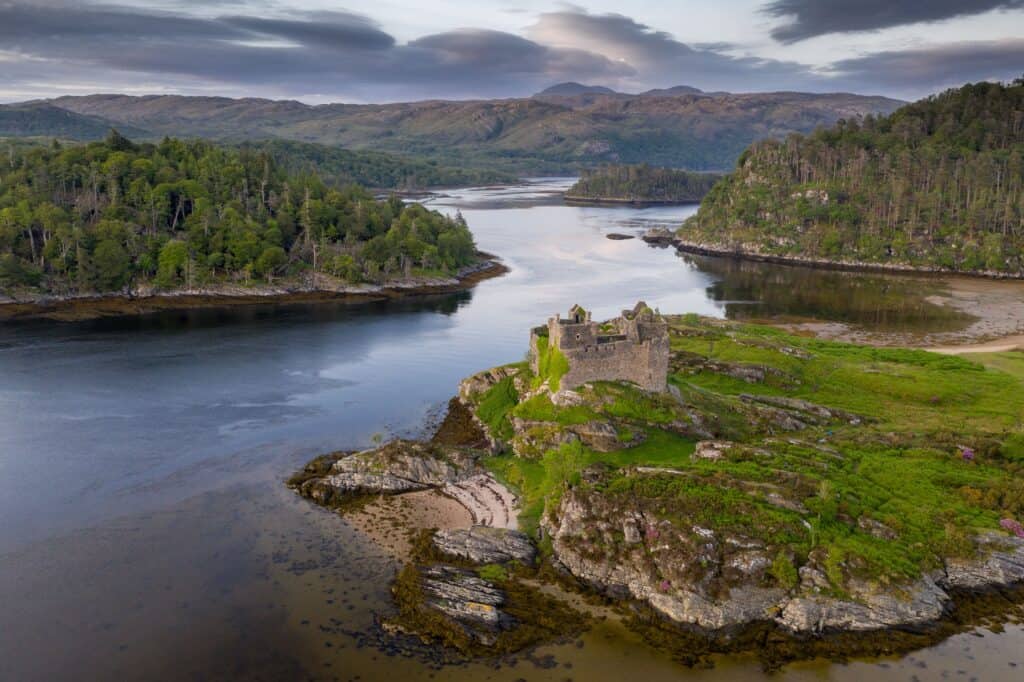
Castle Tioram, or Dorlin Castle, is a 13th or 14th-century abandoned castle located on the tidal island of Eilean Tioram. Historians believe the fort was Clann Ruaidhrí’s stronghold, mainly because they discovered the first written account of the island the estate stands upon, Eilean Tioram, in the writings of Cairistíona Nic Ruaidhrí, Ailéan mac Ruaidhrí’s daughter. Furthermore, they believe Ailéan’s granddaughter, Áine Nic Ruaidhrí, is the one who built the estate. After Clann Ruaidhrí, Clann Raghnaill came and lived at the estate for centuries.
Since then, Tioram Castle has been the seat of clans and the seat of Clanranald, which was a branch of Clan Donald. Unfortunately, when Clanranald’s chief, Allan Macdonald, took the side of the Jacobite French Court, government forces seized the fort in 1692 upon orders from king William II and Queen Mary II.
After that, a small garrison was kept at the fort, but during the Jacobite rising in 1715, Allan reseized and burnt the fort down to prevent Hanoverian forces from seizing it. Tioram Castle was abandoned after that, except for the storage of guns and firearms during the Jacobite Uprising of 1745 and the kidnapping of Lady Grange. Sadly, despite its historical significance, Tioram Castle is in very bad condition, mainly the interior of the castle. You can reach the castle on foot and marvel at its dwindling beauty from the outside, but the risk of falling masonry keeps the inside off to visitors.
Lennox Castle, Lennoxtown
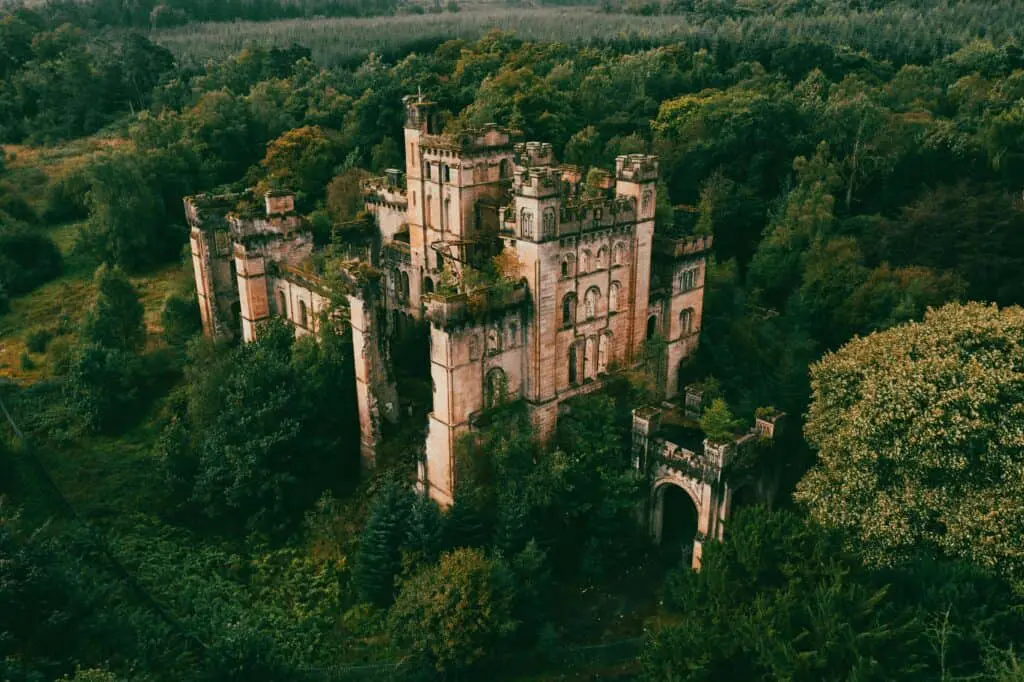
Lennox Castle is a currently abandoned castle north of Glasgow. The estate was built originally for John Lennox Kincaid in 1837 over the course of four years. Glasgow Corporation bought the land, including the castle, in 1927 to establish the infamous Lennox Castle Hospital, a hospital for people with learning difficulties.
When the hospital started operating in 1936, the main castle served as the nurses’ home, while the remaining grounds were patient rooms. Soon afterwards, reports of overcrowdedness, malnutrition and maltreatment began to circle the hospital. Moreover, reports of how poorly the hospital staff treated patients followed. Famous singer Lulu and football player John Brown were born at the hospital’s maternity ward, which was operational between the 1940s and the 1960s.
In 2002, upon a change in how society viewed people with learning disabilities, the hospital was closed, and a policy of societal integration was adopted instead. The castle lay in ruins, especially after a fire in 2008 that caused severe damage. Unfortunately, the castle’s legacy as a residence dwindled by the hospital’s infamous reputation.
Scotland has many castles worth visiting; our list of choices focuses on abandoned castles to make your visit more bone-thrilling and enjoyable. Sadly we have no videos of Abandonded Castles in Scotland – yet! We do have videos of castles dotted around the UK and Ireland – which we share below:
If you are tempted to see more castles videos, make sure to check out our YouTube channel, or if there is a castle he should mention in this article, why not let us know in the comments below?


